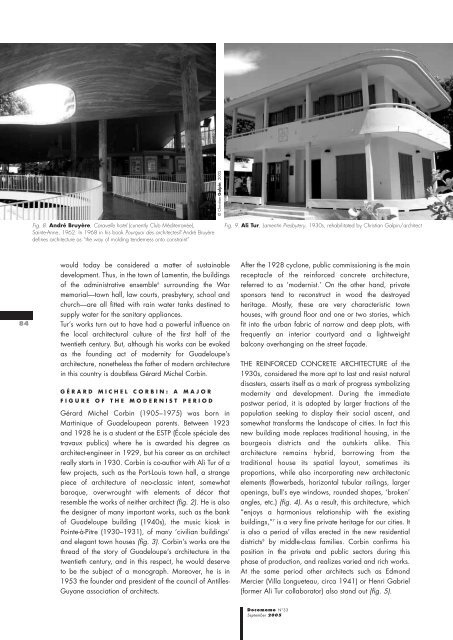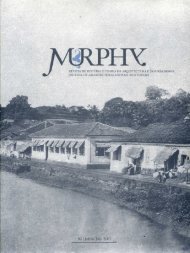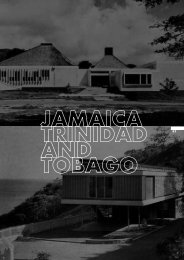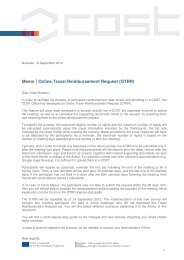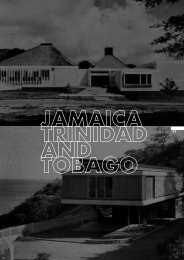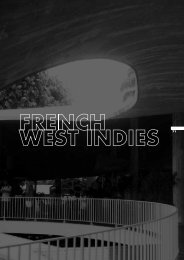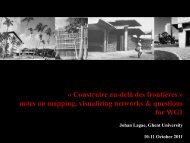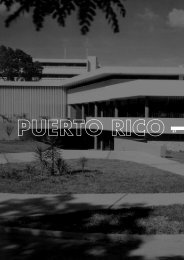Guadeloupe : The Modern Transition
Guadeloupe : The Modern Transition
Guadeloupe : The Modern Transition
You also want an ePaper? Increase the reach of your titles
YUMPU automatically turns print PDFs into web optimized ePapers that Google loves.
© Christian Galpin, 2005<br />
Fig. 8. André Bruyère, Caravelle hotel (currently Club Méditerranée),<br />
Sainte-Anne, 1962. In 1968 in his book Pourquoi des architectes André Bruyère<br />
defines architecture as “the way of molding tenderness onto constraint”<br />
Fig. 9. Ali Tur, Lamentin Presbytery, 1930s, rehabilitated by Christian Galpin/architect<br />
84<br />
would today be considered a matter of sustainable<br />
development. Thus, in the town of Lamentin, the buildings<br />
of the administrative ensemble 6 surrounding the War<br />
memorial––town hall, law courts, presbytery, school and<br />
church––are all fitted with rain water tanks destined to<br />
supply water for the sanitary appliances.<br />
Tur’s works turn out to have had a powerful influence on<br />
the local architectural culture of the first half of the<br />
twentieth century. But, although his works can be evoked<br />
as the founding act of modernity for <strong>Guadeloupe</strong>’s<br />
architecture, nonetheless the father of modern architecture<br />
in this country is doubtless Gérard Michel Corbin.<br />
GÉRARD MICHEL CORBIN: A MAJOR<br />
FIGURE OF THE MODERNIST PERIOD<br />
Gérard Michel Corbin (1905–1975) was born in<br />
Martinique of <strong>Guadeloupe</strong>an parents. Between 1923<br />
and 1928 he is a student at the ESTP (École spéciale des<br />
travaux publics) where he is awarded his degree as<br />
architect-engineer in 1929, but his career as an architect<br />
really starts in 1930. Corbin is co-author with Ali Tur of a<br />
few projects, such as the Port-Louis town hall, a strange<br />
piece of architecture of neo-classic intent, somewhat<br />
baroque, overwrought with elements of décor that<br />
resemble the works of neither architect (fig. 2). He is also<br />
the designer of many important works, such as the bank<br />
of <strong>Guadeloupe</strong> building (1940s), the music kiosk in<br />
Pointe-à-Pitre (1930–1931), of many ‘civilian buildings’<br />
and elegant town houses (fig. 3). Corbin’s works are the<br />
thread of the story of <strong>Guadeloupe</strong>’s architecture in the<br />
twentieth century, and in this respect, he would deserve<br />
to be the subject of a monograph. Moreover, he is in<br />
1953 the founder and president of the council of Antilles-<br />
Guyane association of architects.<br />
After the 1928 cyclone, public commissioning is the main<br />
receptacle of the reinforced concrete architecture,<br />
referred to as ‘modernist.’ On the other hand, private<br />
sponsors tend to reconstruct in wood the destroyed<br />
heritage. Mostly, these are very characteristic town<br />
houses, with ground floor and one or two stories, which<br />
fit into the urban fabric of narrow and deep plots, with<br />
frequently an interior courtyard and a lightweight<br />
balcony overhanging on the street façade.<br />
THE REINFORCED CONCRETE ARCHITECTURE of the<br />
1930s, considered the more apt to last and resist natural<br />
disasters, asserts itself as a mark of progress symbolizing<br />
modernity and development. During the immediate<br />
postwar period, it is adopted by larger fractions of the<br />
population seeking to display their social ascent, and<br />
somewhat transforms the landscape of cities. In fact this<br />
new building mode replaces traditional housing, in the<br />
bourgeois districts and the outskirts alike. This<br />
architecture remains hybrid, borrowing from the<br />
traditional house its spatial layout, sometimes its<br />
proportions, while also incorporating new architectonic<br />
elements (flowerbeds, horizontal tubular railings, larger<br />
openings, bull’s eye windows, rounded shapes, ‘broken’<br />
angles, etc.) (fig. 4). As a result, this architecture, which<br />
“enjoys a harmonious relationship with the existing<br />
buildings,” 7 is a very fine private heritage for our cities. It<br />
is also a period of villas erected in the new residential<br />
districts 8 by middle-class families. Corbin confirms his<br />
position in the private and public sectors during this<br />
phase of production, and realizes varied and rich works.<br />
At the same period other architects such as Edmond<br />
Mercier (Villa Longueteau, circa 1941) or Henri Gabriel<br />
(former Ali Tur collaborator) also stand out (fig. 5).<br />
Docomomo N°33<br />
September 2005


